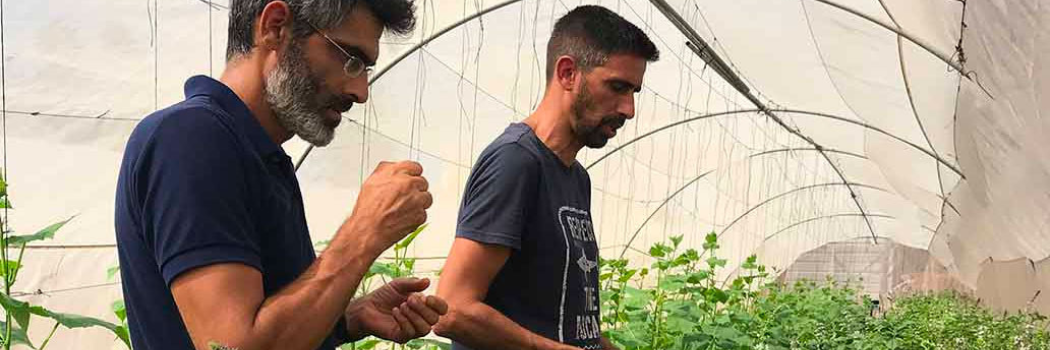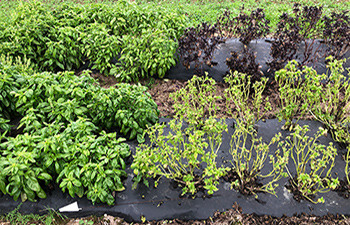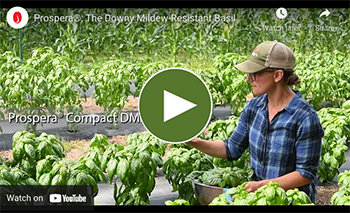- Basil Downy Mildew and Prospera® DMR Basil | Breakthrough Breeding Innovation Provides Solutions
- Prospera® DMR Basil Comparison Chart | Johnny's Selected Seeds
- Video: Prospera® Red Downy Mildew-Resistant Basil
- Video: Prospera® Downy Mildew-Resistant Basil
- Basil | Key Growing Information
- Basil Varieties | Comparison Chart (PDF)
- Hydroponic & Container Basil Guide | Production Advice & Variety Recommendations
- Hydroponic & Container Basil Guide | Printable 4-pp Brochure (PDF)
- Ornamental Basil | Key Growing Information
- Basil Downy Mildew Awareness & Prevention | Tech Sheet (PDF)
- Common Pests & Diseases of Basil | Tech Sheet (PDF)
- Video: 'Everleaf' Basil | The extremely slow-to-bolt, compact Genovese basil
- Beyond Blossoms | Expanding & Diversifying Your Dried Floral Menu
- Getting Started in Cut-Flowers | Top 15 Cuts
- Heat & Drought: How Flower Farmers Are Adapting to Changing & Challenging Climatic Conditions
- Building a Better Market Bouquet: Tips, Techniques & Recipes for Flower Farmers
- Johnny's Edible Flower Guide | Printable 4-pp Brochure (PDF)
- Sustainable Farming Methods | A Survey of Flower Farmers' Best Practices
- Just Add Flowers | An Introduction to Companion Planting for Vegetable & Herb Gardeners
- Succession-Planting Interval Chart for Herbs
- Mia Prospera® Active DMR – Organic Basil Variety from Johnny's
- Lihi Prospera® Active DMR – Organic Basil Variety from Johnny's
- How and When to Prune (Pinch) Basil
- Noga Prospera® Active DMR – Organic Basil Variety from Johnny's
- Webinar Slide Deck | New-for-2023 Vegetables & Herbs | PDF
- Video: High-Value Crops & Varieties for Your Garden • Tutorial with Niki Jabbour
- Video: Disease-Resistant Basils from Johnny's • Tutorial with Niki Jabbour
Basil Downy Mildew and Prospera® DMR Basil
Photo courtesy of Genesis Seeds
Breakthrough Breeding Innovation Provides Solutions
Basil is a high-demand, high-value crop that consumers expect to be flawless on presentation. Growers need access to the best-performing, most disease-resistant basil varieties available, and as a committed partner in the success of our customers, Johnny's strives to supply this need. Running our own basil trials each year is central to informing our variety selections, but equally valuable is hearing from others whose experience, knowledge, and vision have much to teach us.
We connected with three individuals whose line of work puts them face-to-face with basil and the disease now considered to be its most common and damaging threat — basil downy mildew: Prospera® DMR (downy mildew-resistant) basil breeder Dr. Arnon Brand, 40-year commercial grower Brian Murphy, and phytopathologist Dr. Margaret T. McGrath of Cornell, all of whom share a prognosis of cautious optimism. One of the biggest takeaways is that solutions are in the pipeline for today and tomorrow, but vigilance is of the essence in facing down what the days beyond may bring.
Breeding Downy Mildew-Resistant Basil Varieties: Arnon Brand, PhD, Genesis Seeds
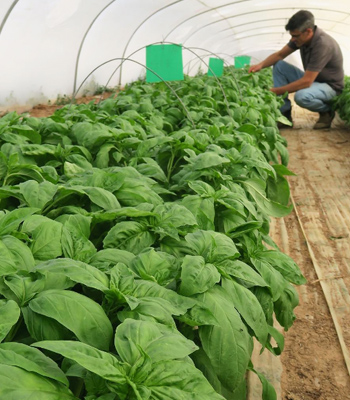
Dr. Arnon Brand manages the plant breeding program at Genesis Seeds, a family-owned organic seed production and research company based in Israel's Negev desert. Founded in 1994 by Dr. Isaac Nir, Genesis is a remarkable company in many ways, but its focus on organic products really stands out. The Genesis breeding portfolio includes solanaceous and cucurbit crops, but as Arnon notes, "First and most important is the basil."
He recounts the initiation of their basil downy mildew program. "Around 6 years ago, 2016, Isaac called me to his room. I was pretty new to the company, so every time he called me to his room I felt dizzy. 'Okay, leave the tomatoes aside,' he told me. 'Now you are responsible for the basil.' I said, 'Okay, I've never worked with basil. What is the main goal in basil right now?' He replied, 'Downy mildew. That is the critical issue. Find a solution to that.' "
Hand-to-the-glove with academia
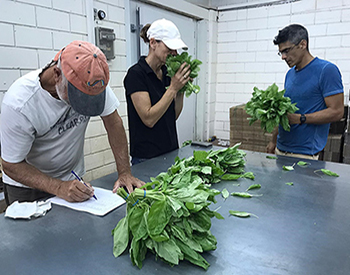
"So, I developed some working plans — which probably would have led nowhere, when I look back. Then I came up with the laboratory at Bar-Ilan, of Professor Yigal Cohen, and gave him a call. Apparently at that time he had just come upon his breakthrough solution to the interspecific cross between two species of basil — a sweet basil and an African basil — which would not usually make reproductive offspring. It was an amazing coincidence. After a few days we just started to work together.
"Although he is a professor, Yigal Cohen has a practical way of thinking. When he sees a good idea, he knows what to do with it. Basically, he was looking for a commercial connection, and he was looking for a small company, so we came to him at the right time. We just fit together very well."
That was the beginning of a wonderful friendship, working together in true partnership to offer better basil varieties. Under the leadership of Prof. Cohen and Dr. Yariv Ben-Naim at Bar-Ilan University, a team of phytopathologists screened hundreds of wild basil species from around the world to locate a source of resistance. Eventually they identified a source from Africa, which they hybridized with a sweet Italian cultivar, to derive a few hybrid plants containing the gene responsible for resistance to downy mildew. Through their collaboration with Genesis, they were able to develop the organic Prospera DMR line and meet all the strict market requirements for excellent flavor, aroma, and overall appearance.
We know the work is never finished
Their success in bringing the resistance from a totally wild plant that doesn't look or smell anything like a sweet Genovese type to a place of commercial value is remarkable. There were many obstacles, but in an arc of success much shorter than usual, the Prospera line has been very encouraging for us all. Arnon adds that it takes hard work and that it couldn't be happening without the synergistic work with the team at Bar-Ilan.
"In basil, we know the work is never finished," he says. "We have already seen some minor breakdowns in resistance in some locations, meaning we know that the downy mildew pathogen is very, very dynamic." As with everyone we spoke with for this article, they have continued to innovate, and new varieties with higher levels of resistance, such as the Active series, are already available, with others in the pipeline.
On a philosophical note, says Arnon, "Young breeders always think they will change the world," but often find themselves in the mainstream, serving growers with more of the same existing varieties." To develop something completely different in just a few years is the exception, not the norm. With Genesis, it has been a different story: "Suddenly, you have this amazing opportunity to take genetic traits from wild species and bring them in. That's really a dream come true for a breeder."
He adds, "When you work with an enormous company, you realize you are a very, very small part of a very, very heavy machine. In a small company, for good and for worse, your decisions make the change. A bad decision could ruin the company, but when it's a good idea — even if it sounds a little crazy — a decision can be made and acted upon, then and there."
Starting small and making sound decisions along the way also kept grower Brian Murphy of Goodness Gardens on the path to success. Brian grew his herb business from a drop in the hydroponic bucket to a multimillion-dollar operation over a 40-year timespan, during which he became one of the first in New York State to encounter basil downy mildew.
Grower Success: Brian Murphy of Goodness Gardens
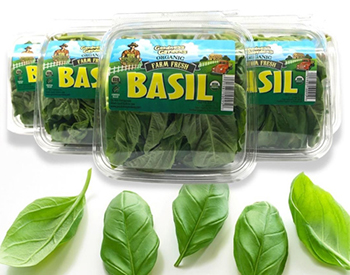
Just 20 years old in 1980, Brian started growing hydroponically in 5-gallon buckets in New York. "We were doing research and back then, it was really the Wild West when it comes to hydroponics."
Very few consumers knew about hydroponics, and marketing their tomatoes, lettuce, and cucumbers was hard going, so in the mid-80s they started adding fresh herbs to their line-up. "Back then, there were no fresh herbs in the supermarkets other than parsley. I had grown some basil hydroponically and brought it in to show the buyer, and they didn't even know what it was!
"From there, we picked up a lot of new business and kept growing and growing and growing. Today we do multimillions in herbs sales a year from here. Now we're building a 2½-acre, high-tech hydroponic greenhouse to grow a lot of the herbs in this fully automatic system, and this is going to be all organic. We also started a sister company in Miami. We have another greenhouse operation in Orlando, Florida and another sister farm out in San Antonio, Texas."
But the course hasn't been a swift or smooth one: Brian has had to adapt to technological and cultural shifts in the hydroponic industry, new variety introductions, and evolving pathogens. He's also been a customer of Johnny's since the early days, so we wanted to hear about his experience with basil downy mildew. We asked him when he first started having issues with it.
Basil downy mildew hits Goodness Gardens
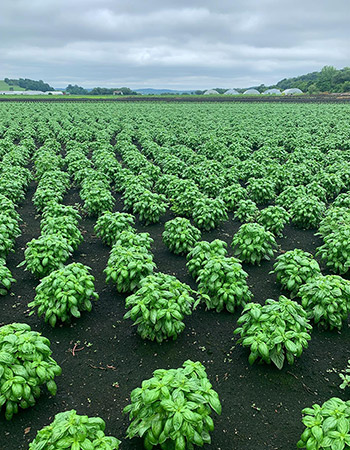
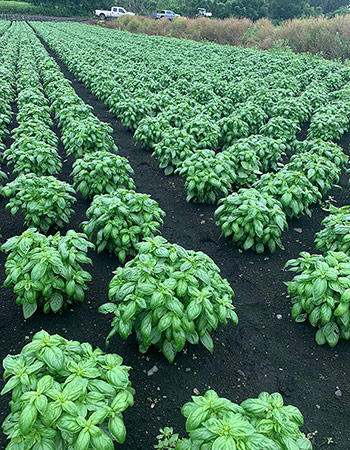
"It was 2012 when it first hit around here. I had a farm out here where we were growing 5 acres of basil; just Genovese. And I remember saying to one of my farm hands, 'I think you need to fertilize the basil; it's turning yellow.' I kept thinking, 'We've got a fertilizer problem,' because I'd never had a problem with basil before. So he goes out and puts on more fertilizer, but during the next couple days, it got yellower. And I thought, 'What the heck is going on here?'
"I started to notice that there was mildew on the underside of the leaves and realized, 'This is something else. I've never seen anything like this before.' Once the plant is infected, it won't recover. Once that fungus turns the leaves even half yellow they don't go back to green, even if you kill the downy mildew. It's dead. That's it. It's done! That made it really tough.
"That was in 2012, when that first started happening. Then Cornell came out with a bulletin about it. They started getting some better ideas, including how to control it. It's been a struggle, because in the beginning the fungicides were not working well, and obviously, there were no downy mildew-resistant varieties yet. It took years for that to happen. But today, between the new varieties that are downy mildew-resistant and the new fungicides it has become… almost not a problem anymore."
In his region, Brian notes, "Downy mildew in the greenhouse here starts in July and ends right around mid-November. In the spring months, it's moving up from the South. That takes until about July 1st. Then once the frost hits — September and October — the spores are killed, and I don't have any more problems for another 6 months."
What about downy mildew-resistant basil varieties?
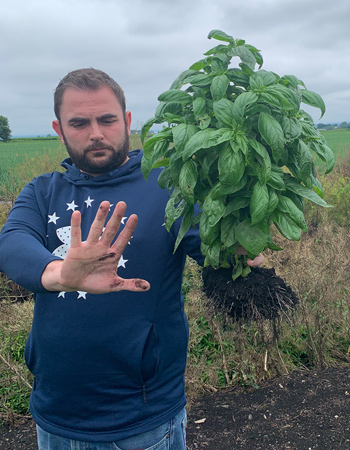
We asked Brian about his experience with resistant basil varieties. While in some of his earlier trials the first-generation varieties demonstrated resistance, he felt they fell short on other qualities like color, leaf shape, leaf size, and plant habit.
In comparing the more recently released Prospera to non-DMR-resistant varieties, he observes, "I noticed it might get some downy mildew but it doesn't spread. It's weird; you'll see it show up on a few leaves but it doesn't go any further. On the regular plants, overnight, you can lose the whole crop. Being able to identify what's going on and spray before it gets any further gives you a huge advantage. You may lose a few leaves here and there, but it's nothing. That's what I noticed that was really good about it.
"This year, in our outdoor fields, we had no outbreak of downy mildew. Now we were doing a maintenance spray every week. But last year, we lost 10 acres of basil. We weren't using Prospera. This year, we used only Prospera in the field and didn't even see it out in the field. So that is a big change."
Brian is guardedly hopeful that the disease can be brought under better control. "I hear they're coming out with new varieties, in the Prospera category, that are even better." But after 40 years of growing, he recognizes that even as new tools become available, the ongoing challenge with a lot of pathogens is that they continue to evolve.
Managing the thrust and parry between this pathogen and its host is a goal Brian shares with one of the leading experts in the U.S. in basil downy mildew.
Monitoring, Reporting & Management: Margaret McGrath, PhD, School of Integrative Plant Science, Cornell

Dr. Meg McGrath is a New York-based plant pathologist whose primary directive is conducting practical research on diseases of vegetable crops with a focus on management. When asked how she came to work on basil downy mildew, Meg explains, "Because many diversified vegetable growers in our region grow basil, it was logical, when downy mildew appeared, for me to do some research, learn more about the disease, and share that information.
First and foremost, we needed a monitoring program
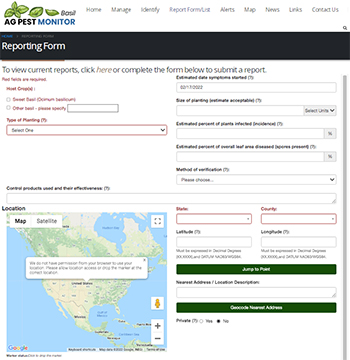
Meg says she had her eyes opened to the disease with the first reports of its spread to the U.S. in October 2007. "In 2008 we first saw it here on Long Island. When it made a reappearance in 2009, the first thing she did was to set up a monitoring program so anyone (grower, extension specialist, gardener) could immediately report observations of downy mildew.
Digging deeper to develop a resistance program
Meg had previously worked on Phytophthora infestans, the notorious cousin that causes late blight in tomatoes and potatoes, and was working on cucurbit downy mildew, which had started to become more prevalent in 2004.
"I got into doing research in 2010, initially evaluating fungicides, work that was supported by the IR-4 program, which supports research to register products, both conventional and organic, for specialty crops. We were able to convince them that basil downy mildew was a topic that needed to be worked on. I got into evaluating resistant varieties in 2013 through USDA-funded projects."
Pathogens do their own thing
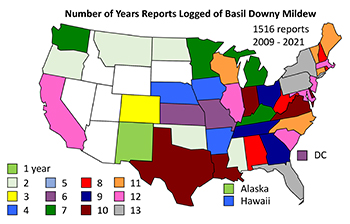
Examining new and established DMR varieties was again a topic of Meg's research last year, and here are some of her observations:
- "In 2021, as in 2020, I saw downy mildew more on the Rutgers DMR lines than in the past, but still much less than on the susceptible variety.
- "I've always seen some downy mildew on the Rutgers DMR lines but less than on earlier DMR varieties like 'Eleonora', whereas on the parent for their resistance, we did not see any symptoms when tested previously.
- "On Prospera, I've seen exceptional control of downy mildew, including this past year, when adjacent Rutgers DMR lines did not do as well in years past. That was a surprise.
But as an experienced pathologist, Meg cautions that
"I've received a few reports of people seeing more downy mildew than in the past on Rutgers DMR lines, as well as a couple reports of people seeing downy mildew on the Prospera lines. So the pathogen may have made multiple kinds of changes to overcome resistance. We may be in a situation similar to spinach downy mildew, where breeders are going to have to work hard and continually find new resistance genes."
Verification & reporting matter
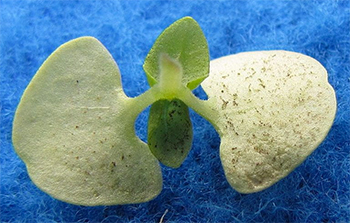
Many plant diseases closely resemble each other or problems that are physiological, such as nutrient deficiency, rather than pathological. To avoid misdiagnosis and inappropriate treatment, Meg adds, "You have to verify the pathogen's present. My experience has been, if spores aren't visible on the underside of yellow basil leaves, put them in a moist plastic bag overnight, and if it's downy mildew you're going to see the spores within a day."
Through the AgPest Monitor program she initiated, Meg confirms they have learned a lot about how widespread it can be in the U.S. "I think one of the greatest values of the monitoring programs is in the mapping. It is so much easier to look at occurrences and see them on a map than to see them in a spreadsheet format. That has been really valuable in keeping people engaged.
"What I find really interesting is that most of the reporters have been gardeners. They are not treating their basil, so they are more likely to see downy mildew."
Hard to avoid, hard to manage
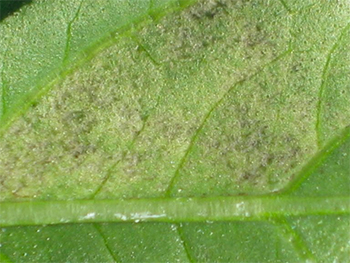
"I think the bottom line for management is that growers have to use an integrated program," Meg says. Along with adopting an integrated approach, Meg suggests reckoning with the disease as something you cannot avoid. "You're dealing with a pathogen that is spread by wind; the pathogen produces spores that can move long distances. And, like other mildews, it's a disease you can't manage through crop rotations."
Meg also points out that although we may think of drought conditions as being less likely to promote downy mildews, "It's the nighttime when pathogens are most active. We've had summers with long rain-free periods — which is not unusual for Long Island — and we feel as though we're not really experiencing 'disease weather.' Then you look at the nighttime conditions and it's nearing 100% humidity, the temperatures come down from the day, and the pathogens are going, 'Hmm, this is great!' Especially downy, which is just looking for high humidity and even better, a good dewy night; I've seen my best symptoms after a heavy dewy night.
"Growers have to be on their toes and expect that this disease is possibly going to show up every year. The pathogen is likely going to keep evolving on us — or, maybe it won't — that was our expectation with the late blight pathogen. It was one of the first to develop resistance to fungicides, and we thought that would keep going, but it hasn't. We're not always good at predicting what's going to happen! But it is safe to assume the pathogen is going to keep changing.
"It's valuable for growers to realize that downy mildew is a hard disease to manage adequately, especially in an herb crop. I have found through my research that if I started spraying after seeing symptoms in my planting, then I wasn't going to get good control. Now I start before we see symptoms — I think that is really critical. With a fresh herb, there is no tolerance for symptoms on the leaves. That's what you're marketing. That makes the situation different from something like cucurbit downy mildew, where yes, with poor control you're going to have a reduction in yield and fruit quality, but the pathogen isn't directly affecting what you're marketing so total crop loss won't occur as it can with basil. I think that, too, makes basil downy mildew a tougher disease to control — it's attacking what you're trying to market, and it's a fresh green."
The importance of both formal and informal reporting structures
"The other thing I would point out," says Meg, "as we're talking about pathogens possibly evolving and changing, is for growers to realize that does happen and that they need to be on their toes — but they also need to share when they see something unusual.
"The best person for them to share it with would be their local extension specialist. Be it that they have used a resistant variety that they used in the past and saw good efficacy with it, and now, all of a sudden, they're seeing a lot of symptoms — then report it. Or, maybe they have a great fungicide program, that worked great last year, but this year it's not working so well — that, too, is something to report.
"Communicating with extension personnel makes it possible for applied pathologists to look at the grower's pathogen and see if it has changed in some way, or to just try to assess what's happened." It also gives the extension agent an opportunity to pass information along to other researchers and plant breeders who are working on these crops.
"And, same with seeing a new disease. Not that many years ago, basil downy mildew was brand new. We could have another brand new pathogen in the U.S., at any time.
"If as a grower you don't know who is in tune with a new disease, your local extension specialist probably does. Or, they can do the footwork and find out, who is the person in the U.S. to contact, if you have something new happening."
What's Next: Resistance in an Ever-Changing Environment
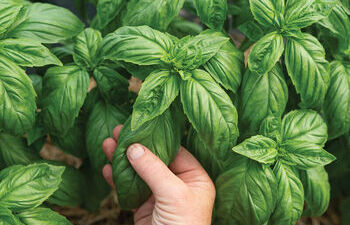
Not too long ago, there were no varieties that showed true resistance to basil downy mildew, but now Johnny's research team trials new "resistant" varieties every year. This past season at Johnny's we had our highest downy mildew pressure to date, which gave us an opportunity to see stark differences in the varieties. We like the Prospera varieties not only because they have shown the highest level of resistance to downy mildew, but also for characteristics like aroma, plant habit, leaf shape, and color — everything that makes basil the beautiful, aromatic, delicious, high-demand, high-value crop it has become over the past 40 years. This season really proved what the Prospera varieties can do.
In deciding which basil varieties to plant, it's useful to hear from those whose knowledge runs deep into downy mildew strains, monitoring, management, and breeding for resistance. And with such a delicate herb, it's encouraging to find that plant breeding for disease resistance can be successful, especially so in the organic setting. While breeding for resistance against a rapidly evolving pathogen is a developmental process that never really ends, the value of this work extends into the future. "The idea here is to be ready with new resistance when there starts to be actual pressure on the Prospera," says Arnon. "I, as a breeder, need to be ready."
Learn More
Resources from Johnny's
- Prospera®️ DMR Basil Varieties Comparison Chart
- Visit our Basil Grower's Library…
- Browse Prospera Basil Seeds from Johnny's …
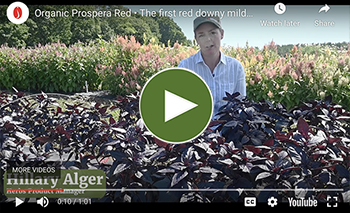
References & Further Reading
Ben-Naim, Y. & M. Weitman. 2021. Joint action of Pb1 and Pb2 provide dominant complementary resistance against new races of Peronospora belbahrii (basil downy mildew). Phytopathology. URL: https://doi.org/10.1094/PHYTO-02-21-0065-R (accessed 01.30.2022; online ahead of print).
Ben-Naim, Y., et al. 2018. Transfer of downy mildew resistance from wild basil (Ocimum americanum) to sweet basil (O. basilicum). Phytopathology, 108 (1), 114–123. URL: https://doi.org/10.1094/PHYTO-06-17-0207-R (accessed 12.30.2021).
Ben-Naim, Y., et al. 2015. Resistance against basil downy mildew in Ocimum species. Phytopathology, 105 (6), 778–85. URL: https://doi.org/10.1094/PHYTO-11-14-0295-R (accessed 12.30.2021).
McGrath, M.T. 2021. Basil downy mildew. Cornell University. URL: https://www.vegetables.cornell.edu/pest-management/disease-factsheets/basil-downy-mildew/ (accessed 12.30.2021).
Patel, J.S., et al. 2021. Effective downy mildew management in basil using resistant varieties, environment modifications, and fungicides. Plant Health Progress, 22 (3), 226–234. URL: https://doi.org/10.1094/PHP-02-21-0041-FI (accessed 01.30.2022).


